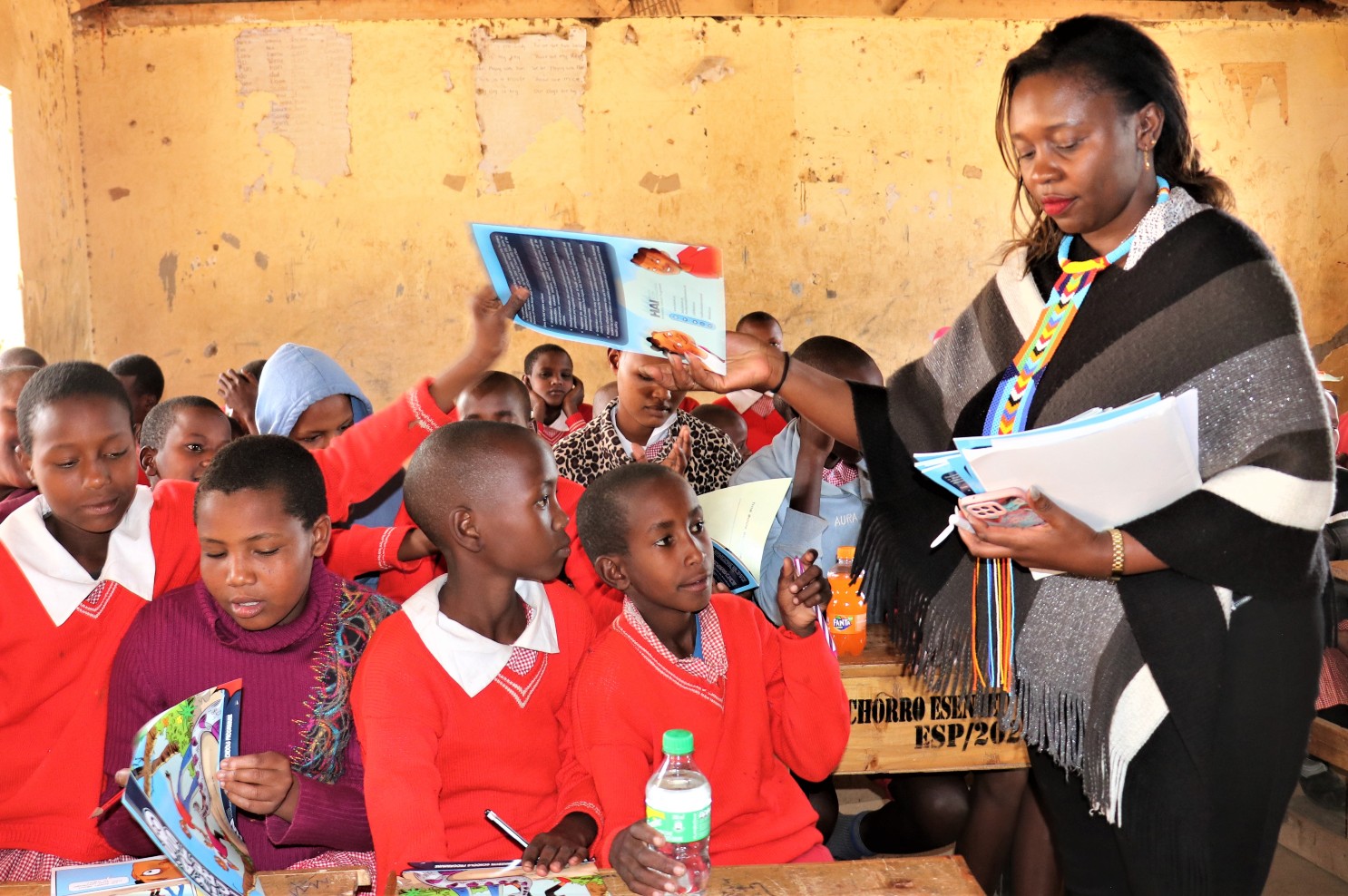By Henix Obuchunju
Kajiado County, Kenya: The life of Ntunti Lenkiboko Lemperuwa, a pastoralist of Mile 46 village in Kajiado East, Kenya, took a turn in January 2022.
One evening while he was journeying from the grazing field towards his Manyatta homestead along a narrow path, he stumbled upon a snake that was camouflaged in the dwarf shrubs that lines his walkway.
In retaliation, the reptile spat saliva into his left eye. The snake then slithered away, unidentified, leaving him with a permanent irritation.
“On arrival at the hospital, I was received by a nurse who washed the affected eye with some medicine before discharging me.”
To date, Ntuti’s eye itches during the morning hours and is blinded by the brightness of the sun or any other source of bright light.

Ntunti Lenkiboko Lemperuwa at Mile 46 Market in Kajiado West (Photo: Henix Obuchunju)
The only temporary remedy to his lifelong struggle is washing his eye with plenty of water.
His village, he says, has been under the torments of high temperatures due to a lack of rainfall for the past year. The strong sun has compounded the problem in his eye.
A 2018 study published by the Institute of Climate change and Adaptation, hosted at the University of Nairobi, showed a declining trend in the annual average rainfall over the past 30 years in Kajiado County
The weather outlook by the Kenya Meteorological Department shows that October, November, and December have always been short of rainfall in Kajiado County. But this has worsened in the past five years going by recent developments in the country. The National Drought Management Authority is also raising an alarm over the worsening drought in the county. It had been named as one of the counties experiencing a normal drought phase, but that has worsened.
Increased Risk of Snakebite
A household survey conducted by the American Society of Tropical Medicine and Hygiene titled The Burden of Snakebite in Rural Communities in Kenya found that among the seventeen cases of samples surveyed, five were from the black-necked spitting cobra which is common in Kajiado. According to the study, the reptile is fond of targeting the eyes of the victim.
A conservation group in Kenya, Wildlife Direct, also notes that the venom of this snake causes pain, swelling, blistering, and damage to body tissues.
Living Zoology, an online publication focusing on the documentation of wild venomous and non-venomous snakes, contends that the red spitting cobra mostly likes living in dry thorny vegetation where the soil is extremely red such as Kajiado County.
Being concentrated in eastern Africa, the black-necked spitting cobra has a widespread habitat, including temperate and tropical areas, where annual temperatures average 18°C in the highlands and 26.5°C in the lowlands. The cobra is present in these areas but is most common in the drier, warmer lowlands such as savannas and semi-deserts like Kajiado. This reptile can survive with body temperatures from 0 to 40 °C; anything outside of this range is considered life-threatening. (Mailafiya, et al., 2009; Wuster and Broadley, 2003; Wuster and Broadley, 2007).
It’s not just black-necked spitting cobras that residents have to fear. Research shows that puff adders, black mambas, and boom slang are behind the majority of the snake bite cases in Kenya.
The bite of the puff adder is a medical emergency and can be fatal if the patient is not treated appropriately and on time.
Puff adders rely on its camouflage to avoid detection because of its slow ability to move, this is according to Mary Mumbi, a snakes’ conservation officer at Wildlife Direct, an organization that ensures justice for wildlife, empowers people to coexist with wild animals, and responds to emerging issues.
“Oftentimes, it lies in wait for its prey on paths, increasing the likelihood of being stepped on when people move around or visit outdoor bathrooms at night,” Mary says.
Ntuti, the 60-year-old father of five, observes that the number of snakes in his area has increased over time.
The data appears to corroborate his observation. Kajiado County director of Public Health and Sanitation Samson Saigilu says that the local administration recorded a record 400 snake bite cases in 2021 alone, an increase of 30% over the same period five years ago.
At Entosopia Health Center in Magadi ward, Kajiado West Sub-County, at least five cases of snake bites are reported every month, especially when the area heats up. Samuel Ngure, the nursing officer, adds that children and men are the most affected in the three years he has been working at the facility.
Further studies reveal a potential looming crisis if the climate crisis worsens.
Victor Wasonga, a herpetologist working at the National Museums of Kenya, explains: “When it gets too hot, snakes look for cooler areas because they are trying to move from adversity to conducive areas like human settlements to survive too.”
Researchers aver that increased warming is likely to push snakes used to lower temperatures to higher altitudes in search of their preferred lower temperatures.
A shortage of antivenom compounds the threat
A few miles from Ntunti’s home lives a 19-year-old widow, Charity Sayinka. Her daily work is to look after a herd of cattle that her husband left behind.
Charity’s husband died in 2021 following a snake bite as he went to save a friend who had been attacked by an elephant. Charity was told that no one ever saw the snake that bit him. Her husband arrived at the nearest hospital three (3) hours later and was pronounced dead soon afterward.
“It took 3 hours to get to a nearby hospital. The hospital had no anti-venom,” Charity recounts. At Singiraine dispensary where most of the patients are taken to, there is no antivenom as the government has never sent any stocks since the year began.
“After a snakebite, we give the patient hydrocortisone and other antibiotics for tetanus prevention. After that, we refer to Kajiado county Referral hospital within 24 hours. Unfortunately, these commodities are currently out-of-stock,” says Rose Melita, a nurse in charge at Singiraine dispensary asking the government and well-wishers to provide this commodity.

Charity Sayinka standing next to his late husband’s grave in Kajiado West Constituency (Photo; Henix Obuchunju)
Shortage of antivenom is common in most parts of the county; something that forces some patients to opt for treatment at private clinics. Here, a vial of antivenom costs between Sh5,000 and KSh7,000 said Rose.
Saigilu says that the treatment of snake bites has been underfunded and asks the national government of Kenya to sort out the long-standing shortage of antivenom.
Dorothy Okemo, executive director, of Access to Medicines Platform, worries that few philanthropists have invested in antivenom production making it difficult to find long-term solutions as the government has not pumped enough resources to support the independent production of antivenom. Her non-governmental organization advocates for policy changes to ensure universal coverage in Kenya.
Agnes Lanet Nkoshumu, another herdswoman, is not leaving anything to chance at her homestead which is located a few meters from Mile 46 Health center.
She was also bitten by a snake in early 2022 while fetching firewood in the backyard of her house.
Agnes has taken the initiative of clearing all bushes around her homestead. “This is simply meant to destroy their habitat and push them away from my Manyatta,” Agnes explains.

Agnes Lanet Nkoshumu at her home in Kajiado West Constituency (Photo: Henix Obuchunju)
Habitat destruction exacerbates the problem
Actions like Agnes’ may, however, be counter-productive in the long term.
The 2019 Kenyan census report shows Kajiado County’s population almost doubled from 687,312 in 2009 to 1,117,840, signifying a high demand for settlement.
Global Forest Watch, an online platform that provides real-time information about where and how forests are changing around the world shows Kajiado, between 2010 and 2021, lost 1.94 thousand hectares (kha) to deforestation from an original forest cover of 26.55 Kha.
According to the Ministry of Environment, the situation is however worrying because Kajiado County has a forest cover of just a paltry 3.6% against the expected 10%. Speaking on July 20, 2022, after launching a million indigenous tree planting drives in Kajiado County, former Environment and Forestry Cabinet Secretary Keriako Tobiko said among the environmental challenges facing the county is unabated environmental destruction of trees for charcoal burning. As natural habitats for wild animals are destroyed, and human activity encroaches into their space, the risks of snakebite will continue to intensify.
Indeed, a 2022 study by Abdellah Bouazza and others shows global warming and the expansion of human settlements in many parts of the world have led to a dramatic increase in the number of people bitten during encounters with venomous snakes.
Victor the herpetologist, notes: “Increased temperatures and rains in some regions may push some species to some areas. This shift may overlap into a human settlement thus increasing the chances of interaction between humans and snakes,” he says.
As a remedy, to reduce the incidence of snake bites, Victor recommends planting more trees in areas prone to snake bites and stoppage curbing the clearing of natural habitats.
Until then, for Kajiado County, reptiles will continue mingling with human beings as they fight for the few resources available.
Misconceptions abound; awareness important
Mary Mumbi from Wildlife Direct believes that educating residents on how to avoid snake bites and conserving the environment is the best approach to curbing human-snake conflicts.
Victor, for his part, points out that not all snakes are dangerous, and advises residents to exercise caution before killing them.
Dorothy Okemo, executive director at the Access to Medicines Platform, agrees that the only way to tackle snake bites cases in the country is to sensitize communities.
“It was very surprising for us to learn that even the healthcare workers and doctors that the community depends on had a lot of myths and misconceptions around snake bites,” she adds.
It is for this reason that Dorothy and colleagues launched a school health program for snakebites where they visit schools in Kajiado and conduct community education sessions with teachers, community members, and students.
“Some people prefer the use of herbs when bitten but the method is not effective,” adds Saigilu, of the county’s Public Health and Sanitation department, says.
For that reason, Dorothy believes the idea of visiting schools could work because demystifying some of the myths while the children are young will help them in long term.
Her organization also targets younger children with comic books that have messages on how to avoid being bitten by snakes.

Dorothy Okemo distributing comic books to Enchorro Esenteu Primary School Kids in Kajiado West Constituency (Photo: Henix Obuchunju)
Dorothy noted that most people do not know the first aid steps to follow upon snake bite. The Access to Medicines Platform proposes the following measures to avoid being bitten by snakes; sleeping on raised surfaces to avoid reach by snakes that move on the floor; sealing holes that may allow snakes into the interior of the house; not storing firewood inside the house, and using bed nets to restrict movement of snakes in case they strike at night.
This story was produced with support from Internews’ Earth Journalism Network.














